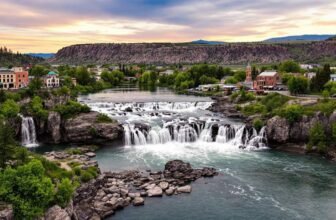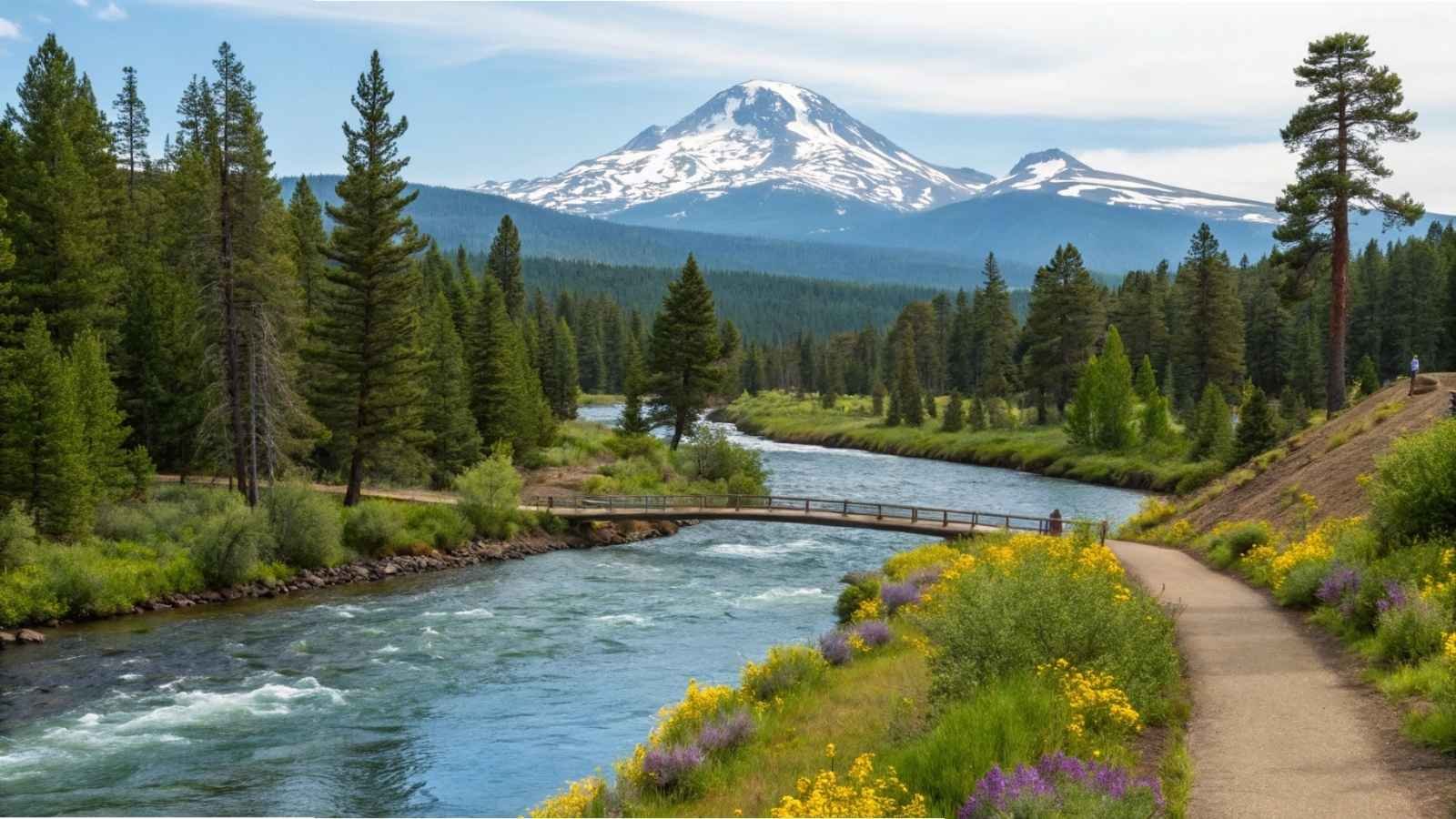
There comes a time in life when peace matters more than pace, and where you live becomes part of your legacy. For many retirees, it’s not just about lower taxes or better weather, but waking up each day with natural beauty right outside the door and the freedom to enjoy it.
That’s where the magic of scenic trails comes in. Paths offer more than just places to walk—they become companions, routines, and quiet reminders of why you chose this next chapter.
We’ve gathered 15 breathtaking trails where retirement isn’t just sustainable—it’s soulful. Let’s explore where your feet—and future—might take you.
1. Asheville, North Carolina – Blue Ridge Parkway Trails

Rich in the gorgeous Blue Ridge Mountains, Asheville serves as a lively retirement community adjacent to the storied Blue Ridge Parkway. Perfect evidence to all those in retirement from The Parkway has hundreds of miles of panoramic mountain trails, everyone should be wearing hiking boots and be eager for a breath of fresh air. The spirit and why Asheville is what it is are mountain-town, a cultural mix. Outdoor vibes of into-nature be-in, live music venues, brew house, and art galleries.
The trails are very accessible, everything kind of loops like Craggy Gardens or Mount Pisgah, on up into more moderate nature areas. Being able to hit the trail because you could? That’s the kind of retirement perk you don’t read about in brochures. And if your knees aren’t what they used to be, the drive alone is worth the move—those ridgeline views are breathtaking in every season.
From a financial perspective, Asheville isn’t the cheapest town in North Carolina, but it offers excellent value for what you get: moderate property taxes, plentiful Medicare-accepting providers, and an abundance of outdoor wellness activities that help keep medical costs down. It’s no wonder advisors call it a “wellness multiplier.”
Quick Facts:
- Best Months to Visit: April–June, September–October (peak foliage)
- Trail Type: Paved and unpaved hiking, biking, and scenic drives
- Closest Healthcare Centers: Mission Health (large hospital network)
- Walkability: High within downtown; trail access by car
- Cost of Living: Slightly above the national average, but manageable
- Local Perks: Farmer’s markets, Bluegrass festivals, top-rated breweries
2. Boulder, Colorado – Flatirons & Mesa Trail
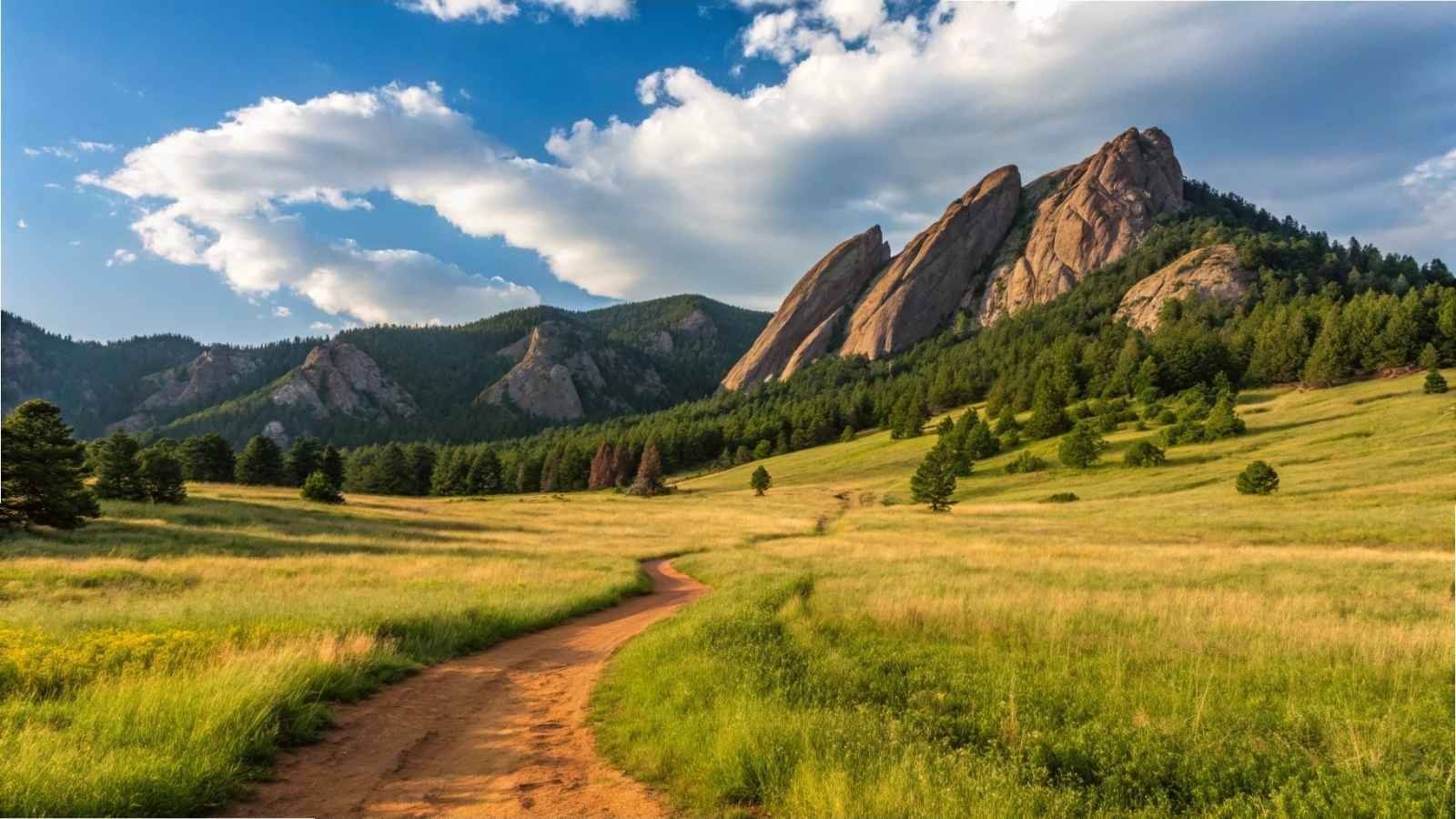
When financial planners talk about “quality of life,” Boulder often tops the list. It’s home to the iconic Flatirons, those dramatic, slanting sandstone formations that seem pulled straight from a postcard. The Mesa Trail, a relatively moderate, 6.7-mile route beneath the Flatirons, offers views that make you forget about time—and maybe even about taxes.
But the magic of Boulder isn’t just its scenery. It’s the infrastructure supporting an outdoor lifestyle: perfectly maintained paths, designated bike lanes, and public benches in scenic places. Locals say “people retire into shape here”—and they’re only half joking. If you’re looking for an active retirement that doesn’t require flying to the Rockies, Boulder is the Rockies.
From a financial standpoint, Boulder can be pricey. However, many retirees downsize here after selling high-value properties elsewhere. With no state tax on Social Security and relatively good access to top-tier healthcare (including UCHealth and specialized care), it’s a smart pick for health-minded retirees with a solid retirement portfolio.
Quick Facts:
- Best Months to Visit: May–June, September–October
- Trail Type: Moderate inclines, scenic overlooks, wildflowers
- Healthcare Access: UCHealth, Boulder Community Health
- Climate: 300+ sunny days per year
- Cost of Living: High, but offset by strong amenities
- Local Perks: Vibrant downtown, yoga in the parks, mountain co-ops
3. Sedona, Arizona – Red Rock Scenic Trails
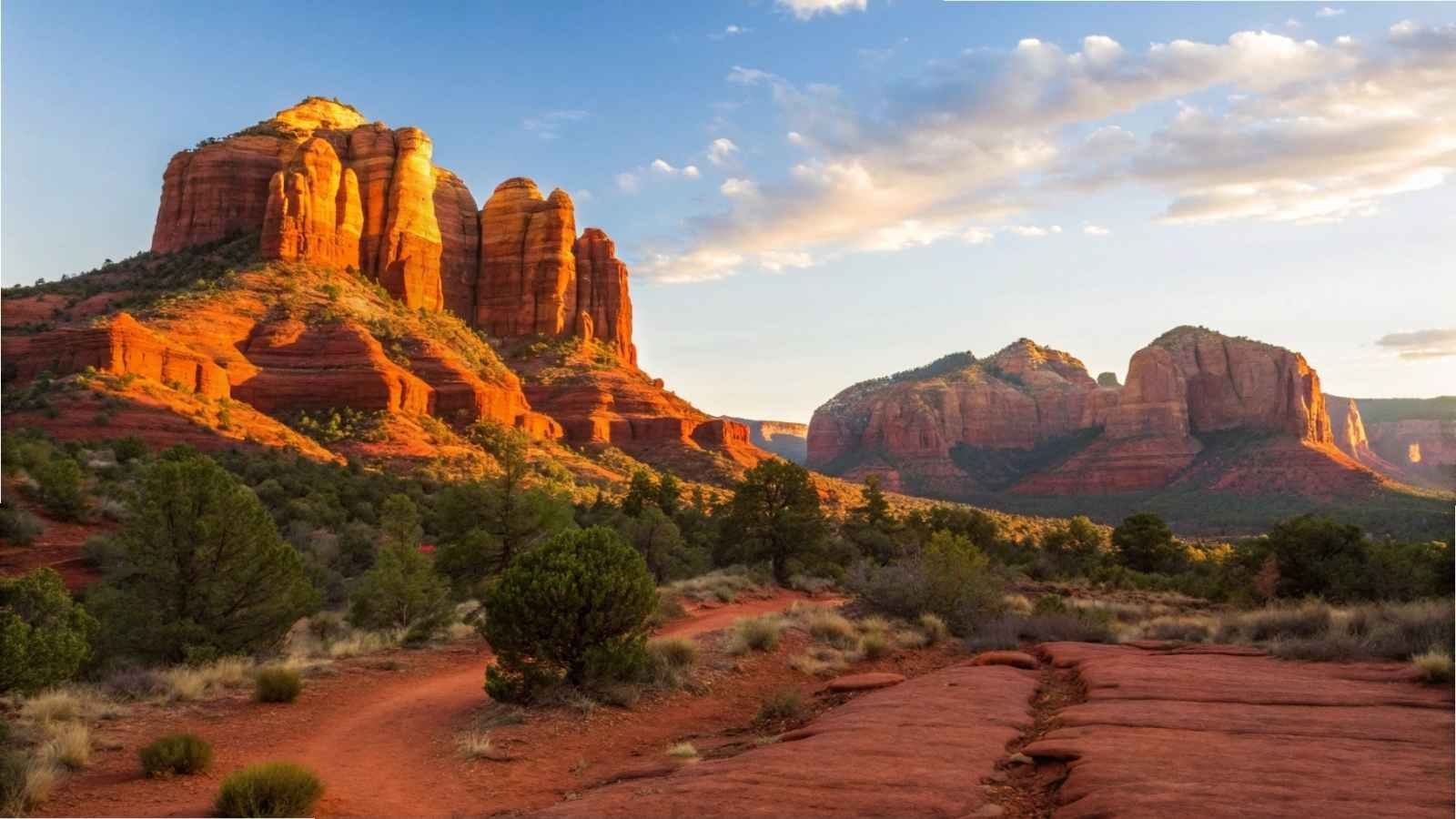
Sedona is not just a trail-loving utopia—it is commonly known as a “red rock spiritual cleanse”. Northern Arizona has some of the most epic trails in town (Cathedral Rock, Devil’s Bridge, and Bell Rock Pathway are all in a smaller town). Full of rich color terrain, deep shadows, and soaring elevation textures, all sitting under some of the Southwest’s most photogenic light.
While many come for the Instagram shots, retirees stay for the dry air, natural beauty, and peacefulness. There’s a real sense of calm here—maybe it’s the vortexes, maybe it’s the lack of traffic lights. And while the elevation keeps things cooler than the desert lowlands, winter still feels like spring to anyone used to shoveling snow.
Financially, Sedona is attractive because Arizona doesn’t tax Social Security income, and the cost of living, while slightly above average, is far from the nosebleed levels of Scottsdale or California. Retirees find it’s a place where health (physical and mental) improves naturally, thanks to all the time spent outdoors.
Quick Facts:
- Best Months to Visit: March–May, October–November
- Trail Type: Moderate to challenging; sandstone terrain
- Healthcare Access: Verde Valley Medical Center is nearby
- Elevation: 4,350 feet (cooler than Phoenix)
- Cost of Living: Slightly above the national average
- Local Perks: Art galleries, healing centers, crystal shops, wine tours
4. Bend, Oregon – Deschutes River Trail & Cascade Lakes

If you’re into rivers, mountains, and the scent of pine, Bend is your dream retirement town. Once a logging town, it’s now a booming retirement and remote-worker enclave. The Deschutes River Trail, running through town and along the rushing river, is perfect for low-impact daily walks, while nearby alpine trails in the Cascades offer day-trip-worthy adventures.
Bend manages to be both peaceful and packed with activities. Retirees here kayak in the morning, grab a microbrew at lunch, and attend a community concert in the park at dusk. And even with its rising popularity, Oregon’s lack of sales tax helps keep daily expenses down.
Financial advisors like Bend because it’s a place where your money buys quality of life—safety, scenery, and clean air. The healthcare scene is solid, anchored by St. Charles Medical Center, and while housing prices have crept up, they’re still more affordable than in many comparable outdoor havens.
Quick Facts:
- Best Months to Visit: May–September (sunny and dry)
- Trail Type: Riverfront walks, forest hikes, alpine lake loops
- Healthcare Access: St. Charles Health System
- Climate: Four seasons with mild winters
- Cost of Living: Moderate to high; no sales tax helps
- Local Perks: Breweries, fly fishing, skiing in winter
5. Bozeman, Montana – Gallatin Range & Hyalite Canyon
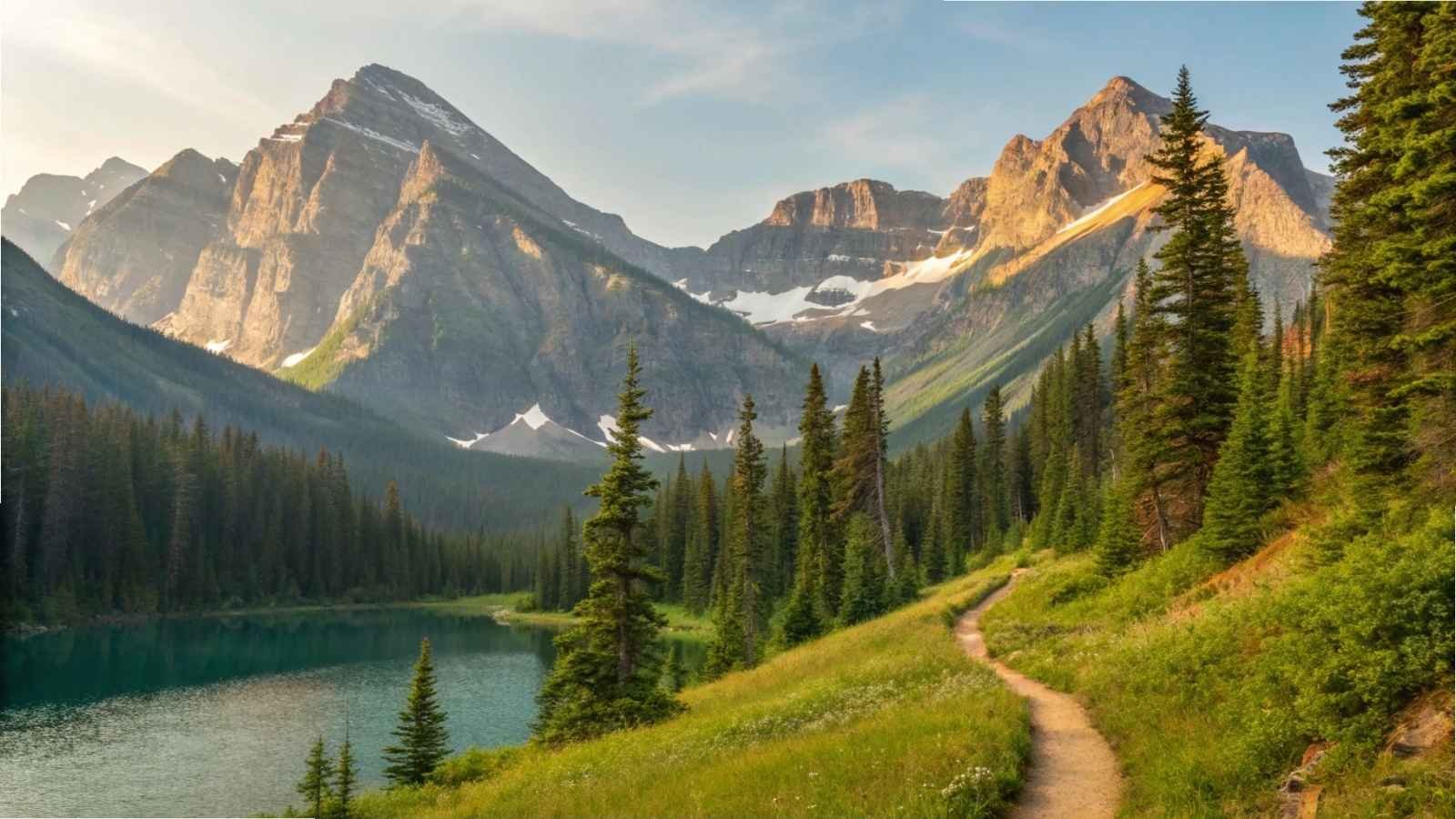
Bozeman is Montana’s scenic darling, where the mountains start right at your doorstep. The town offers access to the Hyalite Canyon trails and the greater Gallatin Range, with waterfalls, alpine lakes, and wildlife encounters that still feel wild. Retirees who move here usually say one thing: “Why didn’t I do this sooner?”
Bozeman has kept its small-town soul, even as it grows. You won’t find high-rises, but you will find independent bookstores, farmers’ markets, and warm café culture. Outdoor life is baked into the DNA, whether it’s a gentle hike or a fly-fishing outing on the Gallatin River.
For financial planners, Bozeman is a long-term investment in health and happiness. Montana doesn’t tax Social Security, and property taxes are lower than the national averages. Plus, with Montana State University in town, there’s access to continuing education and a youthful, energetic vibe that keeps retirees feeling plugged in.
Quick Facts:
- Best Months to Visit: June–September
- Trail Type: Mountain, alpine, and waterfall hikes
- Healthcare Access: Bozeman Health Deaconess Hospital
- Climate: Four-season with snowy winters
- Cost of Living: Moderate; low taxes offset housing
- Local Perks: University town, wildlife, Western culture
6. Santa Fe, New Mexico – Dale Ball Trails
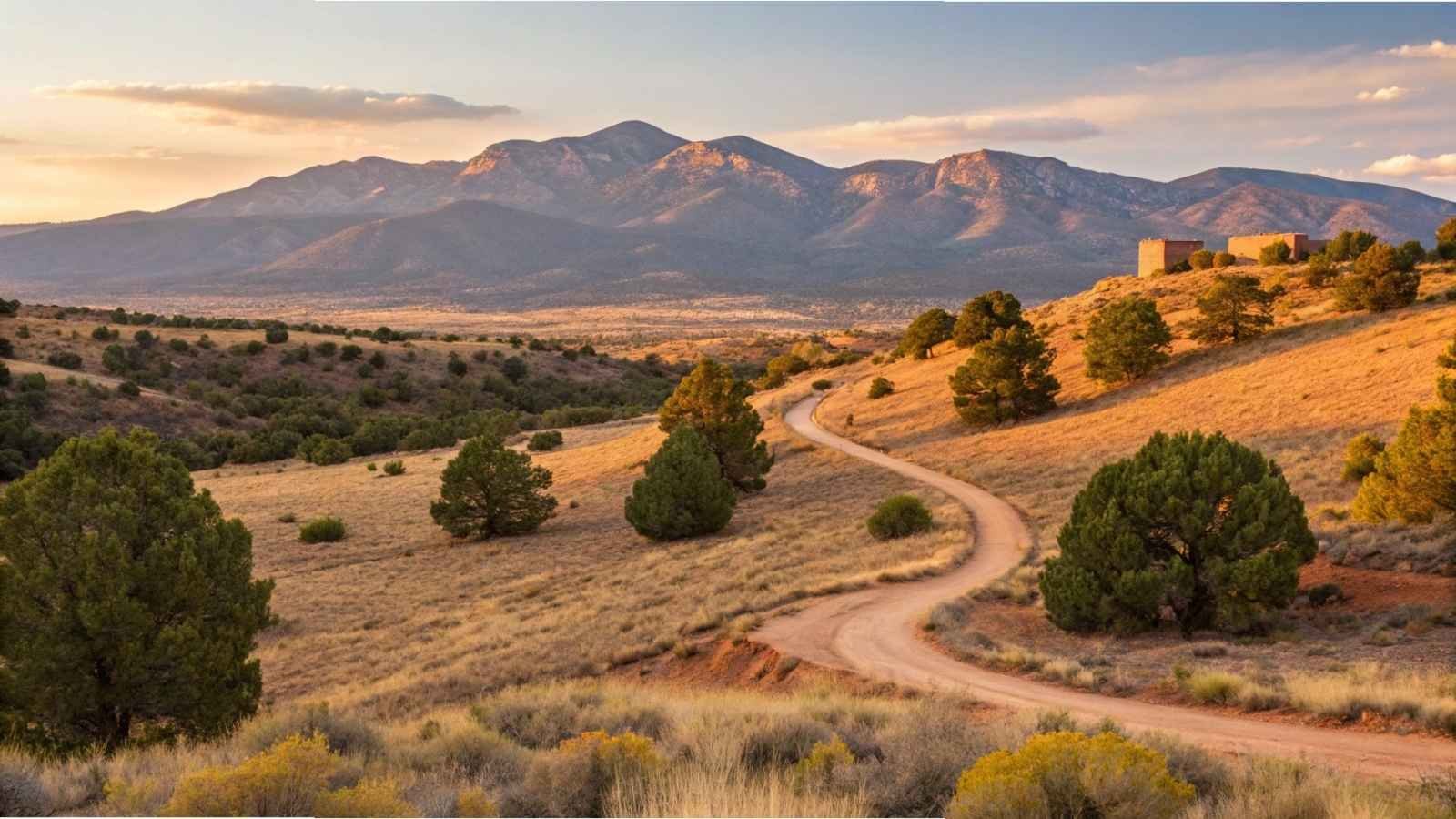
Santa Fe retirement is not just about the southwestern charm and adobe homes, but also because the Dale Ball Trails provide over 22 miles of panoramic views of the Sangre de Cristo Mountains. The trails come out of town in just a few minutes, so this sounds like you can hop from art gallery to peak that same day.
One of the things that draws me to Santa Fe is just how culture is wrapped up with nature and wellness, and the city does. The surroundings change from piñon and juniper to the next, you’ll be walking, suddenly you are soaking in a mineral hot spring, or listening to live flamenco. The dry high-desert climate is easy on joints, and the slower pace encourages a mindfulness that’s hard to find in more urban retiree destinations.
From a financial standpoint, Santa Fe offers good value for retirees. New Mexico taxes Social Security, which is a downside, but housing is still relatively affordable, and the overall cost of living is reasonable compared to cities like Austin or Denver. The climate, walkability, and wellness-oriented lifestyle often outweigh the tax hit in the eyes of advisors.
Quick Facts:
- Best Months to Visit: April–June, September–October
- Trail Type: Loop trails with varied difficulty, desert mountain terrain
- Healthcare Access: Christus St. Vincent Regional Medical Center
- Climate: Dry high desert; ~300 sunny days/year
- Cost of Living: Moderate, with affordable housing options
- Local Perks: Art markets, adobe architecture, natural spas
7. Chattanooga, Tennessee – Lookout Mountain & Riverwalk
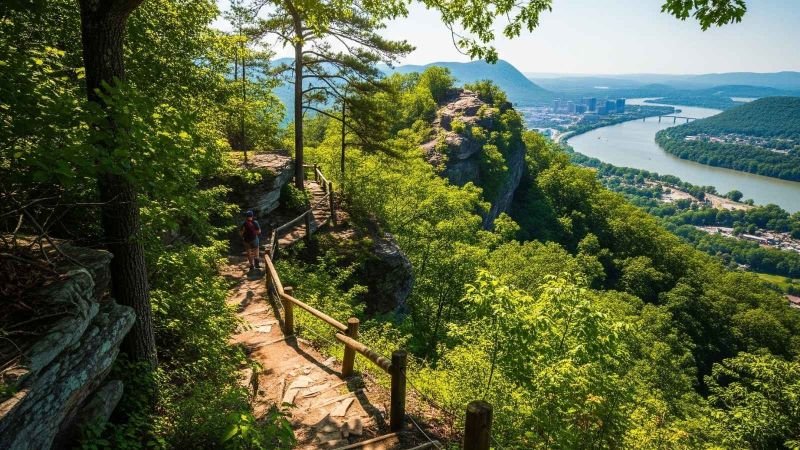
If you’ve never considered Chattanooga, you’re not alone—but financial advisors are increasingly flagging it as a retirement sleeper hit. The city sits on the banks of the Tennessee River and the trails at Lookout Mountain (Sunset Rock, Point Park), not far from having insane Appalachian foothills views right out your trail miles. The Riverwalk Trail is a gorgeous 13-mile path along the river for leisure walking and e-biking.
First, what’s surprising about Chattanooga is how far and fast it’s come — a tech-friendly, clean energy city with gigabit internet and a hip downtown. But it is still, at its core, Tennessee — affordable living, good people, and music on every corner.
From a financial perspective, Tennessee is tax-friendly for retirees, with no state income tax, including on Social Security and retirement income. Housing remains affordable, especially in the surrounding hills, and healthcare access is solid, thanks to the presence of several hospital systems.
Quick Facts:
- Best Months to Visit: March–May, September–November
- Trail Type: Clifftop overlooks, riverside walks, easy and moderate hikes
- Healthcare Access: Erlanger Health System, CHI Memorial
- Cost of Living: Below the national average
- Local Perks: Scenic drives, river cruises, art & history museums
8. Greenville, South Carolina – Swamp Rabbit Trail

Retiring near the Swamp Rabbit Trail doesn’t sound glamorous—until you see it. This 22-mile, multi-use greenway runs from downtown Greenville to Travelers Rest, and it’s become the spine of a thriving, walkable community. You’ll find everything from retirees on e-bikes to kids with lemonade stands alongside it.
What financial advisors love about Greenville is its combination of affordability and infrastructure. The downtown is charming but not overwhelming, and the local government has leaned into sustainable development and smart city planning. For retirees, it means you don’t need to drive much—and that’s a big deal as you age.
South Carolina is also retiree-friendly when it comes to taxes. Social Security isn’t taxed, and there are generous deductions for other forms of retirement income. Greenville has grown fast, but it’s still a place where your dollar stretches and your calendar stays full.
Quick Facts:
- Best Months to Visit: March–May, October–November
- Trail Type: Paved urban-rural greenway, great for walking and biking
- Healthcare Access: Prisma Health, Bon Secours St. Francis
- Cost of Living: Low to moderate
- Local Perks: Small-town vibe, food trucks, lakes nearby
9. Missoula, Montana – Rattlesnake National Recreation Area

Missoula, tucked where rivers meet into Montana’s vast sky, is like one of those places people go and then figure out how to settle. Just down the road, the Rattlesnake National Recreation Area also has over 60 miles of trails that feel remote but are only a couple of minutes from town. Popular with locals are the Rattlesnake Trail and Sawmill Gulch Loop for their forested solitude and chances to see birds.
Missoula itself is walkable, outdoorsy, and just the right amount of quirky. It’s also a university town, so retirees get access to lectures, events, and a younger energy that can make retirement feel more like reinvention. And if fly-fishing is your thing, the rivers here are world-class.
From a financial planning angle, Missoula checks many boxes: Montana doesn’t tax Social Security, property taxes are reasonable, and the lifestyle is more about what you do, not what you spend. You won’t find luxury shopping malls, but you will find open skies and deeply rooted communities.
Quick Facts:
- Best Months to Visit: May–September
- Trail Type: Forest, meadow, and mountain trails; great for wildlife
- Healthcare Access: Providence St. Patrick Hospital, Community Medical Center
- Cost of Living: Moderate, with affordable surrounding areas
- Local Perks: Farmers markets, river surfing (!), arts & crafts festivals
10. Durango, Colorado – Animas River Trail & San Juan Mountains

Small as it is, Durango manages to outclass its size in beauty and lifestyle. Towns are sited along a mountain river in the Animas River Trail, and beyond that are the San Juan Mountains with everything from an afternoon of water to real alpine crowns. There even exists a Grand Canyon Canyon train that goes river canyon style – great for retirees who think still in old age, are nature people.
The town itself is laid-back and colorful, with old-west architecture and a community that values both independence and inclusivity. Whether you’re into mountain biking, pottery classes, or just reading by the river, Durango has a way of making every day feel intentional.
Durango’s financial perks include Colorado’s relatively low property taxes, and the state exempts a large portion of retirement income from taxation. While the housing market has tightened, Durango offers good long-term value, especially for those who prioritize outdoor living over big-city amenities.
Quick Facts:
- Best Months to Visit: June–September
- Trail Type: Riverside walks, forest paths, alpine hikes
- Healthcare Access: Mercy Hospital (Centura Health)
- Elevation: 6,500 feet (cool, dry summers)
- Cost of Living: Moderate to high
- Local Perks: Scenic train rides, ski slopes, cultural festivals
11. Fayetteville, Arkansas – Ozark Highlands Trail
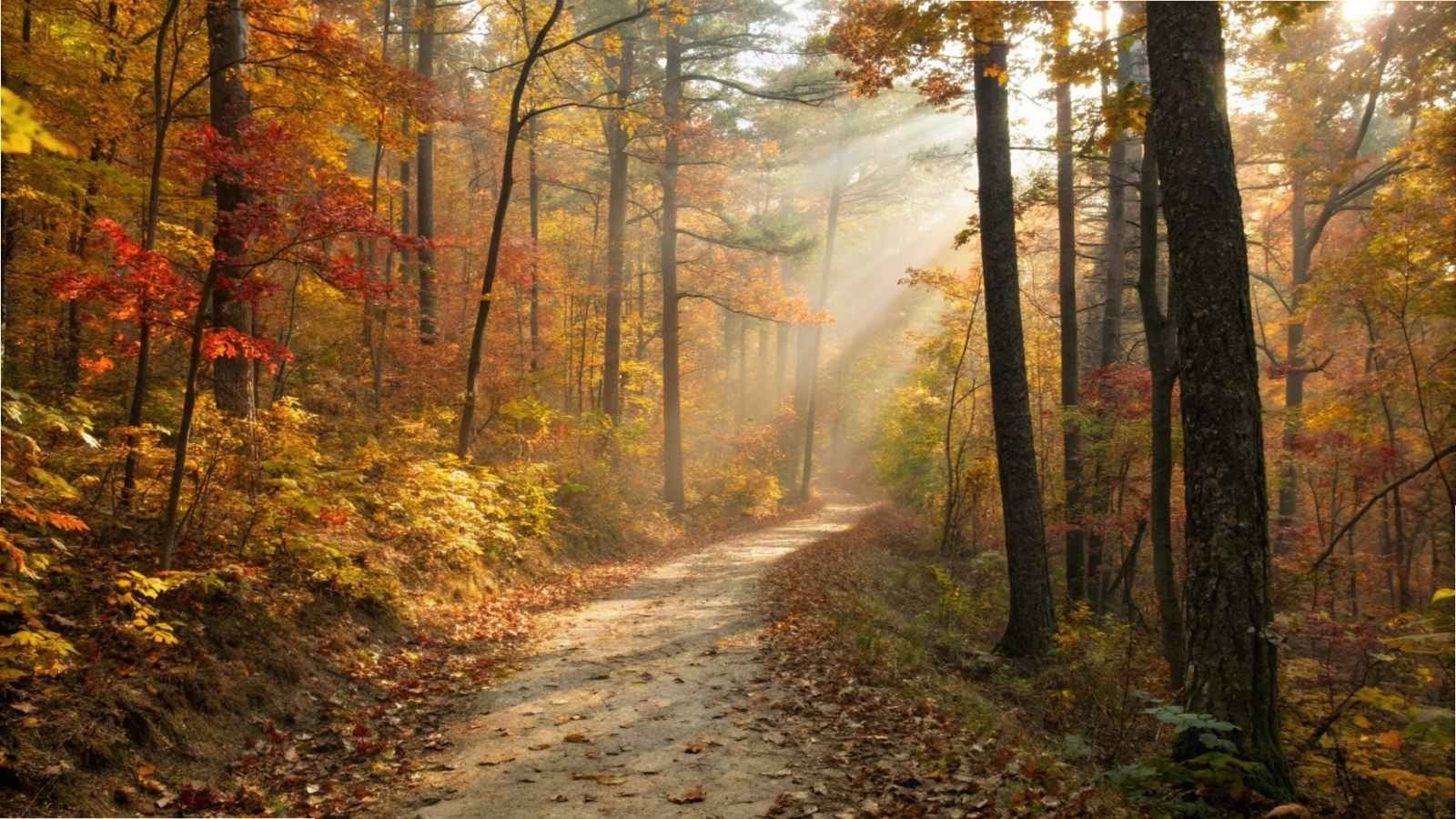
Don’t look at Northwest Arkansas, the quiet retirement haven is becoming more and more established, and one of the Ozark Highlands Trail is another reason. It cuts a grand trajectory through the Ozark National Forest, providing forests the color of emeralds, limestone cliffs, and leisurely waterfalls throughout its length. Short day hikes around White Rock Mountain are an immersion deep in nature without hyperlocalizing to the crowded national parks.
Fayetteville itself is energetic yet mellow, with a lively arts and college scene anchored by the University of Arkansas. What retirees love here is the pace — you can spend your morning hiking through a dogwood-covered ravine and still be back in town for a cozy lunch at a local café. Plus, Arkansas’s natural beauty feels underpriced, and that appeals to financially savvy folks looking to stretch their dollars.
Financial advisors often highlight Fayetteville for its low property taxes, below-average cost of living, and access to Medicare-accepting clinics. And while Arkansas does tax retirement income, the savings from everyday living and real estate often tip the scales in its favor.
Quick Facts:
- Best Months to Visit: April–June, September–early November
- Trail Type: Forested trails, bluff views, moderate terrain
- Healthcare Access: Washington Regional Medical Center
- Cost of Living: Well below the national average
- Local Perks: Farmers markets, college town energy, fall foliage
12. Bar Harbor, Maine – Acadia National Park Carriage Roads

Bar Harbor if you are into ocean views, as well as salty breezes with your trails To wit, Acadia National Park opens right up to Mount Desert Island (home of the charming coastal town and gateway to Bar Harbor) and Carriage Roads are crushed-stone country roads for walking/biking through spruce forests, lakes and rocky coast.
Acadia is one of the most walkable national parks, and that’s part of its magic. You don’t have to submit anything to feel like you’ve been somewhere wild and beautiful. And in Bar Harbor, lobster rolls are more than a menu item — they’re a way of life. The town thrives in summer but slows down just enough in winter to feel peaceful, not deserted.
Maine taxes Social Security, which is a consideration, but Bar Harbor still gets a nod from advisors for its high quality of life, clean air, strong community ties, and easy access to top-tier regional hospitals. For retirees who prize health, nature, and the Atlantic breeze, it’s hard to beat.
Quick Facts:
- Best Months to Visit: May–October (fall foliage is spectacular)
- Trail Type: Paved gravel roads and coastal walking trails
- Healthcare Access: Mount Desert Island Hospital; larger care in Bangor
- Cost of Living: Moderate with seasonal variations
- Local Perks: Whale watching, fresh seafood, artist communities
13. Flagstaff, Arizona – Arizona Trail & Walnut Canyon
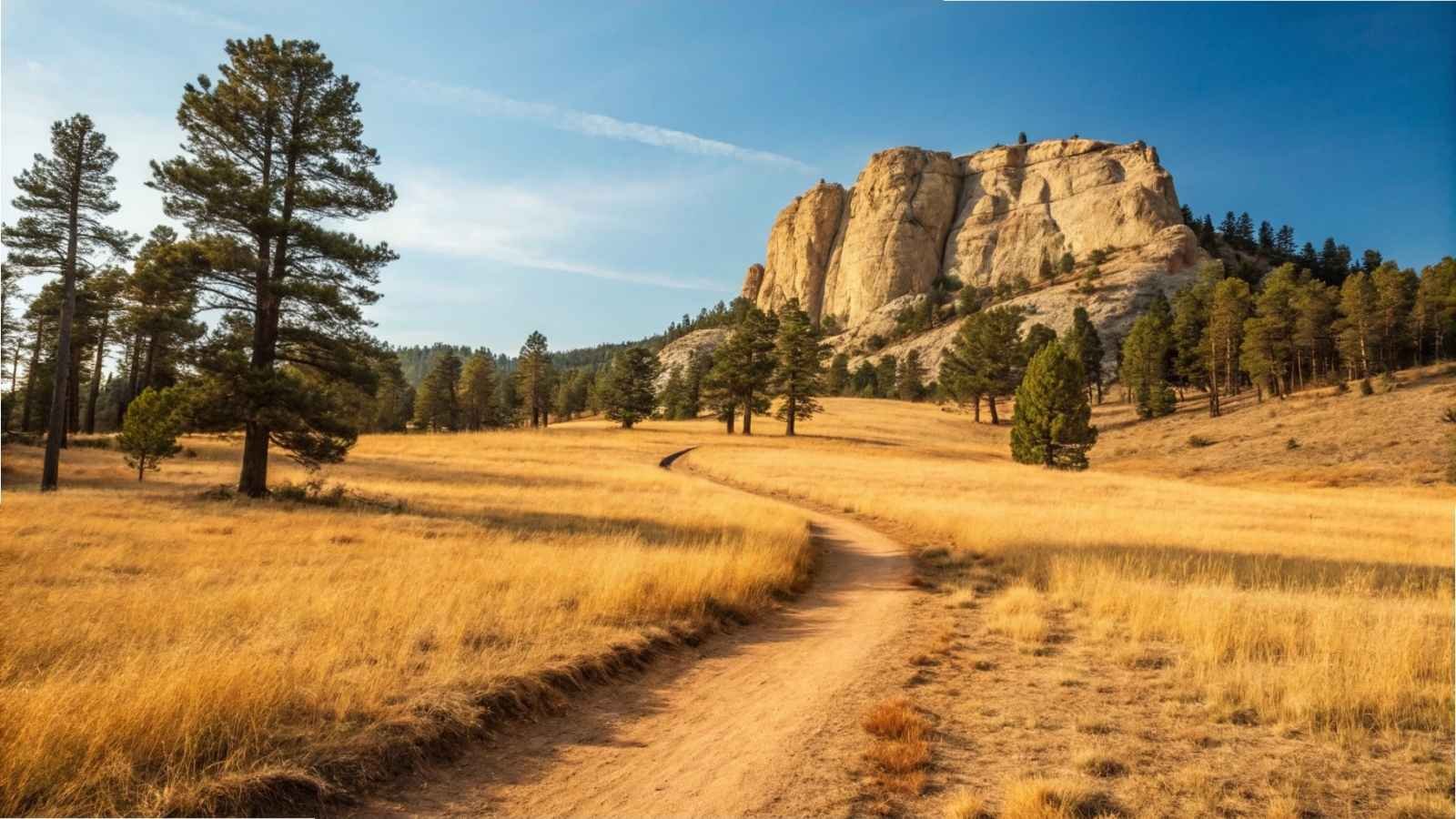
Flagstaff for the folks who want cooler summers, alpine air, and desert views all in one. Covered in pine forests and snow at 7,000 feet, rare elevation-trickery like that in Arizona. The Arizona Trail is a large trail network going from Mexico to Utah. Close to town, there are short trails like Walmquat Canyon Rim trail that provide the retirees with beautiful views for minimal effort.
But Flagstaff is no sleepy outpost — it has a university, a historic downtown, and proximity to the Grand Canyon. Yet it still feels relaxed and friendly, the kind of place where people know your name at the coffee shop and your favorite trailhead.
From a money perspective, Arizona’s retiree-friendly tax structure (no Social Security tax) combined with low property taxes, makes Flagstaff financially attractive despite slightly higher housing prices. And if you ever want a change of scenery? Sedona and the Canyon are both under two hours away.
Quick Facts:
- Best Months to Visit: May–October
- Trail Type: High-elevation forest and canyon trails
- Healthcare Access: Flagstaff Medical Center
- Cost of Living: Moderate to high; offset by low taxes
- Local Perks: Proximity to Grand Canyon, Lowell Observatory, Route 66 history
14. Burlington, Vermont – Burlington Greenway & Lake Champlain Trails

There are trails that it feels as if the town that owns it squeezes up to, like the Burlington Greenway. Nestled along the shore of Lake Champlain, this lakeside trail has great flat walking and cycling with stunning sunset views over the Adirondacks from water level. It will also be very welcoming since kayakers and ice cream vendors are just as likely to share the trail with you.
Burlington offers a unique mix of small-town feel with big-city appeal. There’s farm-to-table dining, live folk music, and one of the best farmers’ markets in New England. It’s a place where retirees say their days feel “rich,” even without spending much. It’s also highly walkable, and that becomes increasingly valuable with age.
Vermont isn’t the most tax-friendly state—it does tax Social Security—but the healthcare system is strong, and many retirees find the trade-off worth it for the high quality of life, safety, and community. Add four distinct seasons and a postcard-perfect downtown, and it’s no surprise that Burlington makes the list.
Quick Facts:
- Best Months to Visit: May–October (or late September for peak fall)
- Trail Type: Paved lakeside paths, accessible walking
- Healthcare Access: University of Vermont Medical Center
- Cost of Living: Moderate; higher housing, lower daily expenses
- Local Perks: Farmers markets, lake cruises, eco-conscious community
15. Eugene, Oregon – Ridgeline Trail System & Spencer Butte
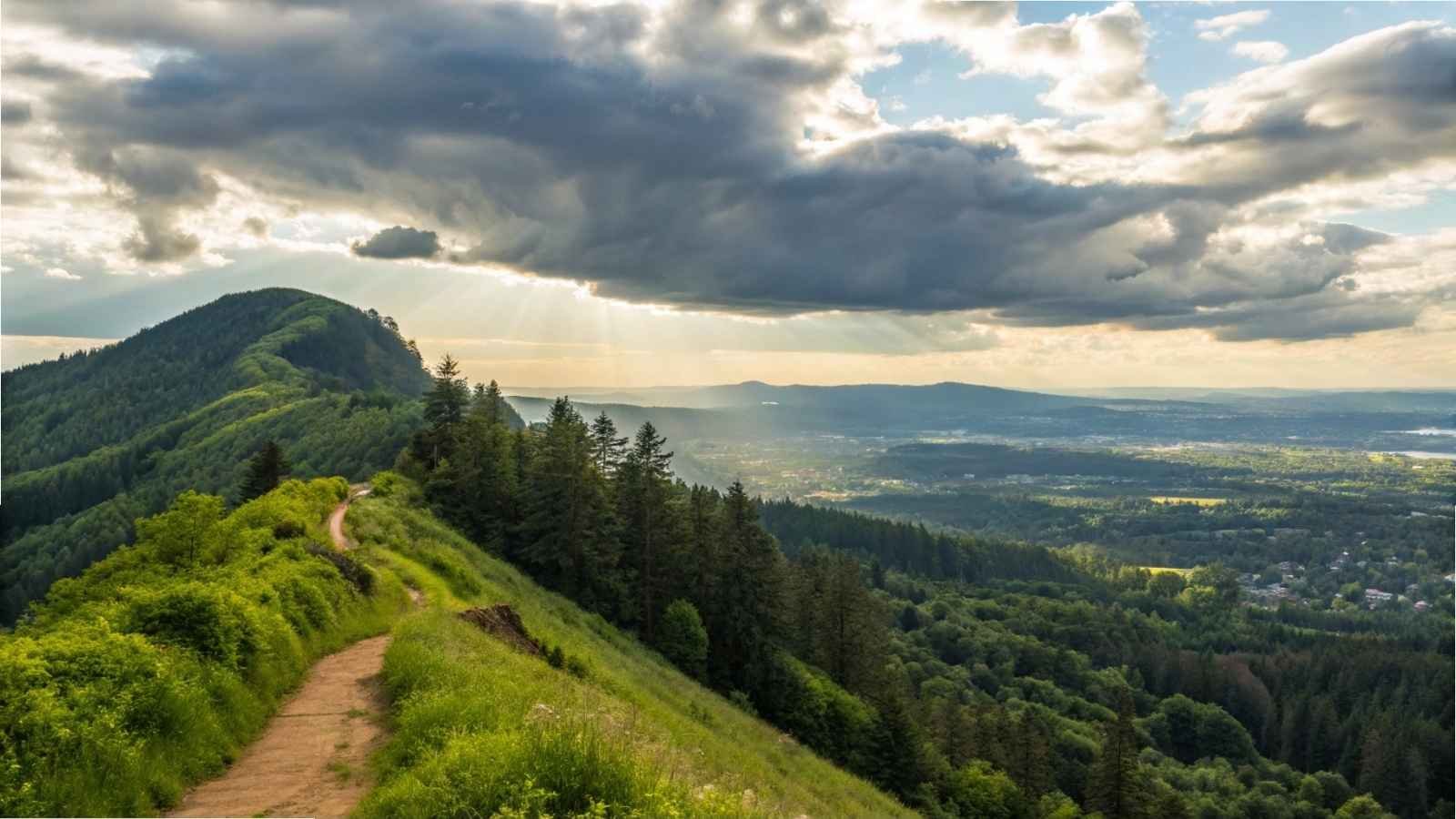
Eugene, sometimes overshadowed by Portland, is quietly one of Oregon’s best trail cities for retirees. The Ridgeline Trail System, including the popular Spencer Butte, brings forested beauty within arm’s reach of town. Some trails even connect neighborhoods directly to nature — no driving required.
The town blends a bit of hippie legacy with a lot of nature-loving sensibility. Retirees here enjoy a slower pace, mild climate, and walkable neighborhoods, often with organic coffee shops and bookstores nearby. There’s also an undercurrent of health-first living — think co-ops, tai chi in the park, and bike lanes everywhere.
From a financial advisor’s lens, Eugene’s perks include no state sales tax, relatively low property tax, and a progressive healthcare system anchored by PeaceHealth and the University of Oregon’s research hospital. While Oregon does tax income (including retirement), the overall quality of life remains a net positive for many.
Quick Facts:
- Best Months to Visit: April–June, September–October
- Trail Type: Forested ridge hikes, town-connected trails
- Healthcare Access: PeaceHealth Sacred Heart Medical Center
- Cost of Living: Moderate, with affordable housing in suburbs
- Local Perks: Outdoor festivals, river walks, arts & wellness culture





